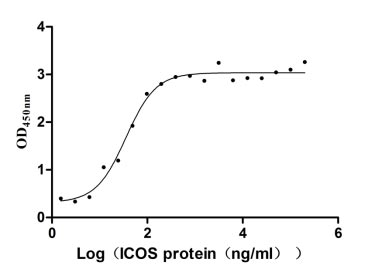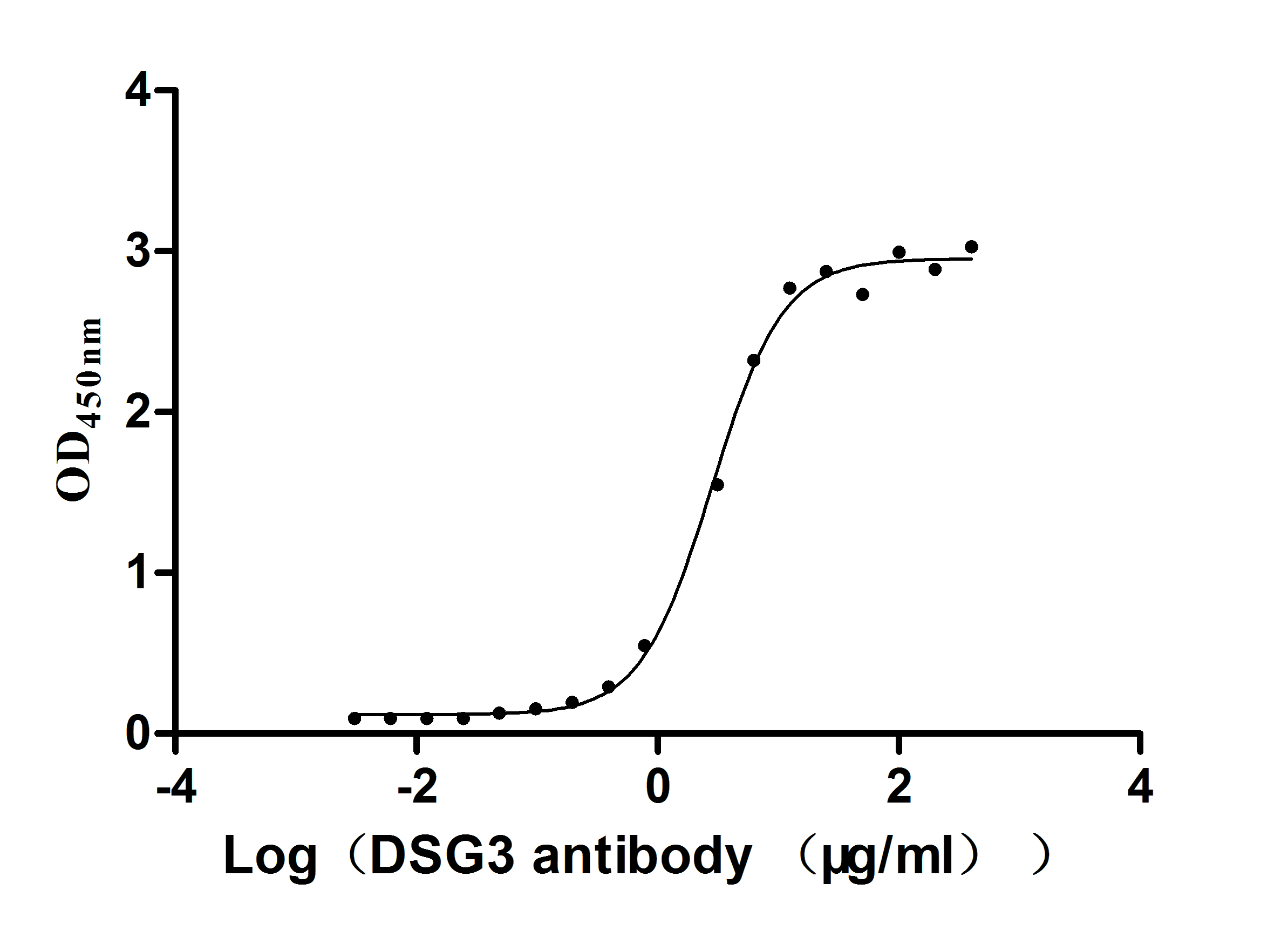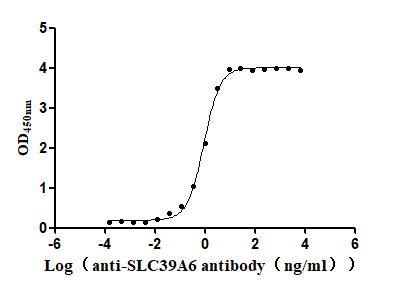Recombinant Rat Synaptotagmin-1 (Syt1), partial
-
货号:CSB-YP023029RA1
-
规格:
-
来源:Yeast
-
其他:
-
货号:CSB-EP023029RA1
-
规格:
-
来源:E.coli
-
其他:
-
货号:CSB-EP023029RA1-B
-
规格:
-
来源:E.coli
-
共轭:Avi-tag Biotinylated
E. coli biotin ligase (BirA) is highly specific in covalently attaching biotin to the 15 amino acid AviTag peptide. This recombinant protein was biotinylated in vivo by AviTag-BirA technology, which method is BriA catalyzes amide linkage between the biotin and the specific lysine of the AviTag.
-
其他:
-
货号:CSB-BP023029RA1
-
规格:
-
来源:Baculovirus
-
其他:
-
货号:CSB-MP023029RA1
-
规格:
-
来源:Mammalian cell
-
其他:
产品详情
-
纯度:>85% (SDS-PAGE)
-
基因名:
-
Uniprot No.:
-
别名:Syt1; Synaptotagmin-1; Synaptotagmin I; SytI; p65
-
种属:Rattus norvegicus (Rat)
-
蛋白长度:Partial
-
蛋白标签:Tag type will be determined during the manufacturing process.
The tag type will be determined during production process. If you have specified tag type, please tell us and we will develop the specified tag preferentially. -
产品提供形式:Lyophilized powder
Note: We will preferentially ship the format that we have in stock, however, if you have any special requirement for the format, please remark your requirement when placing the order, we will prepare according to your demand. -
复溶:We recommend that this vial be briefly centrifuged prior to opening to bring the contents to the bottom. Please reconstitute protein in deionized sterile water to a concentration of 0.1-1.0 mg/mL.We recommend to add 5-50% of glycerol (final concentration) and aliquot for long-term storage at -20℃/-80℃. Our default final concentration of glycerol is 50%. Customers could use it as reference.
-
储存条件:Store at -20°C/-80°C upon receipt, aliquoting is necessary for mutiple use. Avoid repeated freeze-thaw cycles.
-
保质期:The shelf life is related to many factors, storage state, buffer ingredients, storage temperature and the stability of the protein itself.
Generally, the shelf life of liquid form is 6 months at -20°C/-80°C. The shelf life of lyophilized form is 12 months at -20°C/-80°C. -
货期:Delivery time may differ from different purchasing way or location, please kindly consult your local distributors for specific delivery time.Note: All of our proteins are default shipped with normal blue ice packs, if you request to ship with dry ice, please communicate with us in advance and extra fees will be charged.
-
注意事项:Repeated freezing and thawing is not recommended. Store working aliquots at 4°C for up to one week.
-
Datasheet :Please contact us to get it.
相关产品
靶点详情
-
功能:Calcium sensor that participates in triggering neurotransmitter release at the synapse. May have a regulatory role in the membrane interactions during trafficking of synaptic vesicles at the active zone of the synapse. It binds acidic phospholipids with a specificity that requires the presence of both an acidic head group and a diacyl backbone. A Ca(2+)-dependent interaction between synaptotagmin and putative receptors for activated protein kinase C has also been reported. It can bind to at least three additional proteins in a Ca(2+)-independent manner; these are neurexins, syntaxin and AP2. Plays a role in dendrite formation by melanocytes.; (Microbial infection) Receptor for C.botulinum neurotoxin type B (BoNT/B, botB); interaction is improved in the presence of gangliosides. BoNT/B toxin binds to the membrane proximal vesicular domain of Syt1 (residues 32-51).; (Microbial infection) Receptor for C.botulinum neurotoxin type G (BoNT/G, botG); unlike the case with BoNT/B, interaction is not improved in the presence of gangliosides. BoNT/G toxin binds to the vesicular domain of Syt1 (residues 32-53).
-
基因功能参考文献:
- The expression of p-65 is up-regulated in dorsal root ganglion following surgical incision compared to control groups. PMID: 29115943
- Study showed postsynaptic localization of synaptotagmin 1, at concentrations moderately lower than, but comparable to presynaptic concentrations. It is present in significant concentrations at the postsynaptic density, pointing to the likelihood of insertion of glutamate receptors directly into the synaptic plasma membrane. Synaptotagmin 1 is reduced in postsynaptic spines after eight weeks of kainite-induced epilepsy. PMID: 28686803
- The s show that synaptotagmin-1 (from Rattus norvegicus and expressed in Escherichia coli) binds to phosphatidylinositol 4,5-diphosphate via a polybasic lysine patch in the C2B domain, which may promote the priming or docking of synaptic vesicles. PMID: 27791979
- In this study, the s show that the C2B domain of Syt1 interacts simultaneously with acidic membranes and SNARE complexes via the top Ca(2+)-binding loops, the side polybasic patch, and the bottom face in response to Ca(2+). PMID: 27083046
- Data suggest that GTP-binding protein beta/gamma (Gb/g) heterodimers interact specifically with lipid-embedded neuronal t-SNARE proteins syntaxin 1A and SNAP-25B (synaptosomal-associated protein 25B); this binding is competitive with synaptotagmin 1 for binding sites on the t-SNARE proteins; Gb/g inhibits Ca2+/synaptotagmin 1-dependent membrane fusion. PMID: 28515322
- After single synaptic vesicle fusion, syt1 acted as an essential determinant of synaptic vesicle endocytosis time course by delaying the kinetics of vesicle retrieval in response to increasing Ca(2+) levels. PMID: 28111077
- Substitution of 4 Syt1 residues, YHRD, at C2 domain interface, disrupted interaction between tandem C2 domains, altered intrinsic affinity of Syt1 for Ca(2+), and shifted Ca(2+) dependency for binding to membranes and driving membrane fusion. YHRD mutant yielded reductions in synaptic transmission in neurons. Thus physical interactions between tandem C2 domains of syt1 contribute to excitation-secretion coupling. PMID: 26792839
- Study indicates that the accumulation of Synaptotagmin1 may play an important role in axon/dendrite differentiation PMID: 26667128
- different structural states of syt underlie the control of distinct forms of synaptic transmission. PMID: 27001899
- The interaction of Dvl1 with Syt-1, which is regulated by Wnts, modulates neurotransmitter release. PMID: 26400647
- Syt-1 regulates endogenous APP-CTF and Abeta levels in PC12 cells. Syt-1 knockdown reduces APP-CTF, sAPPbeta and Abeta levels. Secreted sAPPbeta levels were significantly reduced in PC12 cells lacking Syt-1 expression. PMID: 26202512
- Membrane interaction of synaptotagmin-1 rather than SNARE binding triggers exocytosis of vesicles. PMID: 26389740
- NMR approach reveals a dynamic binding mode in which basic residues in the concave side of the Syt1 C2B-domain beta-sandwich interact with a polyacidic region of the SNARE complex formed by syntaxin-1 and SNAP-25. PMID: 26030874
- Modifications in the 60-residue linker modulate both the oligomerization of Syt1 and its interaction with opposing bilayers. In addition, the oligomerization of Syt1 may play a role in organizing proteins within the active zone of membrane fusion. PMID: 24973220
- Data suggest that due to the intrinsic copper binding properties of the protein, a pre-labelling approach is preferred for the C2Ac domain of synaptotagmin I when copper is the desired radioisotope. PMID: 23954480
- Analysis of SNARE complex/synaptotagmin-1 interactions by one-dimensional NMR Spectroscopy PMID: 23617808
- the flexible linker region of Syt1 undergoes conformational changes during vesicle fusion: it stretches out to mediate vesicle docking, but folds to assist the C2AB domain for fusion pore opening. PMID: 24001110
- Down-regulation of synaptotagmin 1 in cortex, hippocampus, and cerebellum is associated with experimental subarachnoid hemorrhage. PMID: 23884218
- Iodine deficiency and propylthiouracil treatment reduce synaptotagmin-1 and PSD-95 in the rat hippocampus. PMID: 23321072
- Using PC12 cells from Rattus norvegicus and artificial supported bilayers, s show that synaptotagmin-1 interacts with the polybasic linker region of syntaxin-1A independent of Ca(2+) through phosphatidylinositol 4,5-bisphosphate. PMID: 23665582
- This study demonistrated that synaptotagmin 11 distribution in neuron of rat hippocampus and presynapse and postsynapse. PMID: 22960622
- Synaptotagmin I regulates patterned spontaneous activity in the developing rat retina via calcium binding to the C2AB domains. PMID: 23091625
- It appears that SNAREs alone are sufficient in promoting membrane hemifusion, although Syt1 and Ca2+ are required to carry over toward pore formation and expansion. PMID: 23300284
- synaptotagmin isoforms localize to distinct secretory organelles in both axons and dendrites and may regulate neuropeptide/neurotrophin release to modulate neuronal function. PMID: 22398727
- vesicles have a threshold for syt I that is required to control opening of the fusion pore, expansion, and full fusion to release large dense core proteins, but not for full fusion of small molecules PMID: 22609930
- Trans-interactions of synaptotagmin considered to be essential for its function are controlled by a delicate balance between cis- and trans-binding, which may play an important modulatory role in synaptic transmission. PMID: 22711810
- Dysregulation of SNARE complex and syt-1 in prefrontal cortex of adult-onset hypothyroidism can be restored by T(4) treatment. PMID: 21646859
- PIP(2) makes synaptotagmin-1 >40-fold more sensitive to Ca(2+). This interplay between Ca(2+), synaptotagmin-1, and PIP(2) is crucial for neurotransmitter release. PMID: 22447935
- for Syt1 to function as a Ca2+ sensor, a charge asymmetry appears to be important and this may play a role in steering Syt1 to productively trans bind to the plasma membrane PMID: 22229667
- Synaptotagmin I binds to syntaxin 1 electrostatically through C(2)B domain effector region in a Ca(2+)-independent fashion, providing biochemical evidence that synaptotagmin I binds SNARE complexes before Ca(2+) influx into presynaptic nerve terminals. PMID: 22008253
- syt1 might facilitate SNARE (soluble N-ethylmaleimide-sensitive factor attachment protein receptors)-mediated membrane fusion by phase separating PS PMID: 21610074
- These results suggest a conserved lipid binding mechanism in which Ca(2+)-independent interactions are mediated via a lysine rich region of the C2B domain while Ca(2+)-dependent interactions are mediated via the Ca(2+)-binding loops. PMID: 21928778
- Data suggest that immature medial nucleus of the trapezoid body terminals may contain two populations of synaptic vesicles, one expressing VGLUT3 with synaptotagmin 2 and another expressing VGLUT3 with synaptotagmin 1. PMID: 21456023
- Immunocytochemistry in rat chromaffin cells indicated that Syt1 was localized in large dense-core vesicles and synaptic-like microvesicles, whereas Syt7 was the predominant isoform present in large dense-core vesicles. PMID: 21287204
- investigation of interaction of synaptotagmin 1 (and it's domains) with membrane bilayer PMID: 21344950
- lipid-binding properties of 2 domains of Syt1: C2A domain selectively binds to disordered domains; C2B domain selectively binds to ordered domains PMID: 21322640
- This analysis showed that C2AB domain of synaptotagmin and Ca(2+) accelerate vesicle-vesicle docking with more than two orders of magnitude. PMID: 21320440
- The Syt7 C2B domain structure is very similar to that of the Syt1 C2B domain and contains three Ca2+-binding sites. PMID: 20824061
- Data show that Syt I produced more rapid dilation of fusion pores than syt VII or syt IX, consistent with its role in synchronous synaptic release. PMID: 20573977
- The results suggest that when associated with the SNAREs, syt1 is configured to bind opposing bilayers, but that the syt1/SNARE complex samples multiple conformational states. PMID: 21087613
- the interplay between tomosyn and synaptotagmin-1 underlies inhibitory control of Ca(2+)-dependent neurotransmitter release. PMID: 20978127
- These data support an inhibitory effect of syt IV on release of vesicles and their transmitter content which became more pronounced when syt I expression was abolished PMID: 20735850
- findings show Syt1 requires the membrane anchor to stimulate vesicle fusion at physiological Ca2+ levels and may function as a dynamic presynaptic Ca2+ sensor to control the probability of neurotransmitter release PMID: 20448186
- isolated an SYT1-associated endocytic complex (SAE) from presynaptic nerve terminals and used a novel fractional recovery assay based on electrostatic dissociation to identify SAE components and map the complex structure. PMID: 17183698
- phosphorylation-dependent interaction with cysteine string protein PMID: 11931641
- The InsP6 binding notably weakened the Ca(2+)-dependent C2AB-membrane interaction, which suggests that InsP6 may act as a modulator of neurotransmitter release by altering the state of synaptotagmin-phospholipid interaction. PMID: 12220627
- structure and binding to a truncated neuronal SNARE complex PMID: 12496247
- calcium-independent properties of Syt 1 regulate voltage-gated Ca2+ channels and contribute to the molecular events underlying transmitter release PMID: 12645522
- analysis of palmitoylation sites and processing of synaptotagmin I PMID: 12782290
- The synaptotagmin C2A domain is part of the calcium sensor controlling fast synaptic transmission. PMID: 12873386
显示更多
收起更多
-
亚细胞定位:Cytoplasmic vesicle, secretory vesicle membrane; Single-pass membrane protein. Cytoplasmic vesicle, secretory vesicle, synaptic vesicle membrane; Single-pass membrane protein. Cytoplasmic vesicle, secretory vesicle, chromaffin granule membrane; Single-pass membrane protein. Cytoplasm.
-
蛋白家族:Synaptotagmin family
-
组织特异性:Expressed in the brain (at protein level). Predominantly expressed in rostral, phylogenetically younger brain regions, and in some endocrine tissues.
-
数据库链接:
KEGG: rno:25716
STRING: 10116.ENSRNOP00000049624
UniGene: Rn.216272
Most popular with customers
-
Recombinant Human ICOS ligand (ICOSLG), partial (Active)
Express system: Mammalian cell
Species: Homo sapiens (Human)
-
Recombinant Mouse Desmoglein-3 (Dsg3), partial (Active)
Express system: Mammalian cell
Species: Mus musculus (Mouse)
-
Recombinant Human Tumor necrosis factor ligand superfamily member 9 (TNFSF9), partial (Active)
Express system: Mammalian cell
Species: Homo sapiens (Human)
-
Recombinant Human Nectin-4 (NECTIN4), partial (Active)
Express system: Mammalian cell
Species: Homo sapiens (Human)
-
Recombinant Human R-spondin-1 (RSPO1), partial (Active)
Express system: Mammalian cell
Species: Homo sapiens (Human)
-
Recombinant Human Somatostatin receptor type 2 (SSTR2)-VLPs (Active)
Express system: Mammalian cell
Species: Homo sapiens (Human)
-
Recombinant Human Carcinoembryonic antigen-related cell adhesion molecule 8(CEACAM8) (Active)
Express system: Mammalian cell
Species: Homo sapiens (Human)
-
Recombinant Macaca fascicularis Zinc transporter ZIP6 isoform X1(SLC39A6),partial (Active)
Express system: Baculovirus
Species: Macaca fascicularis (Crab-eating macaque) (Cynomolgus monkey)




















